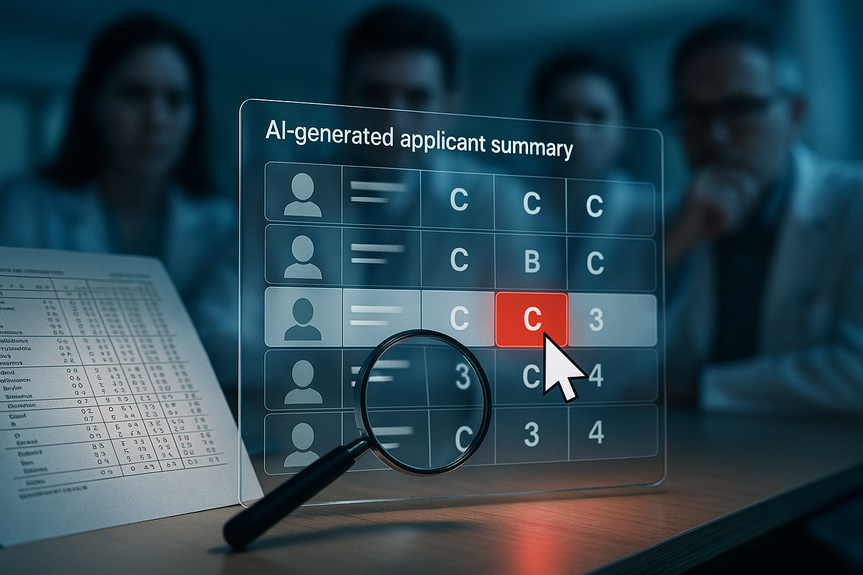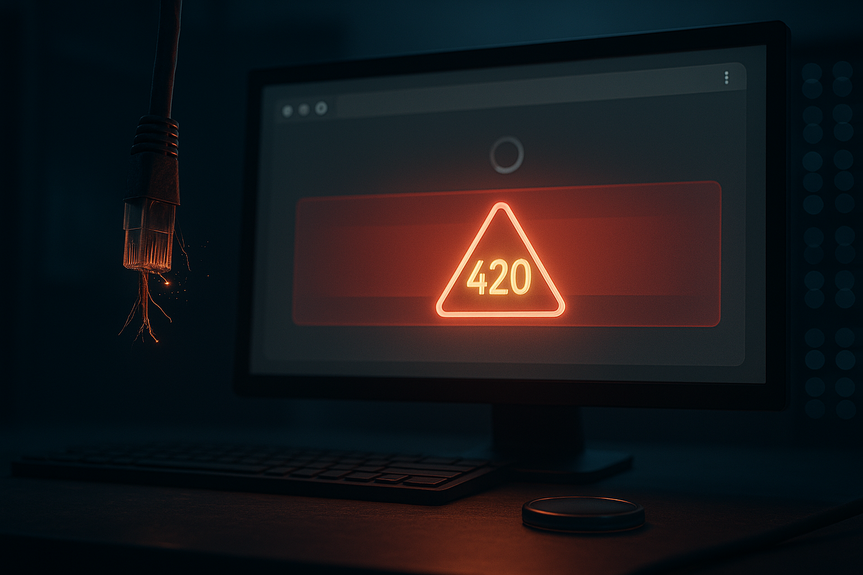Thalamus Cortex residency transcript errors help students find and fix grade mismatches before review.
Residency applicants reported grade mismatches in an AI screening tool this fall. Thalamus Cortex residency transcript errors came from OCR transfers that misread some clerkship grades and displayed them wrongly on summary pages. The company says under 1% of entries were inaccurate, but experts urge strict oversight, fast verification, and clear student visibility.
The residency application season is stressful. Students send dozens of applications and worry about every detail. This year, some learned that an AI screening platform used by programs showed the wrong grades pulled from transcripts. The errors were real but limited. Still, they raised a fair question: What happens when a small mistake touches a high-stakes process?
Thalamus, the company behind the Cortex screening feature, says fewer than 0.7% of extracted grades were wrong and that key data were over 99% accurate. Leadership pointed to optical character recognition (OCR) differences, not “AI hallucinations,” as the cause. Medical AI experts agreed the error rate may be low, but they warned that even rare mistakes can matter when a missed interview could change a career.
Below, you will find what went wrong, what it means for applicants and programs, and clear steps to check, catch, and fix issues fast.
What happened and where the error lived
Thalamus Cortex helps residency programs review and screen applications. Programs see a summary page that highlights grades and other key details from an applicant’s materials. In late September, some of those summaries showed incorrect clerkship grades. The problem came from how the system read and normalized text from transcripts.
The pipeline looks like this:
Schools issue transcripts (often as scans or PDFs).
Software uses OCR to read the text and pull out grades by course or clerkship.
The system maps those grades into standard labels for the summary page.
The company said OCR variances caused some grades to be misread or mis-mapped. Because programs often skim the summary first, an error there can draw attention away from the correct grade shown in the full transcript. Students learned about the issue through blog posts, school alerts, and some program directors who spotted mismatches between the summary and the actual transcript.
Why a small error rate still matters
Residency decisions have high stakes. A single interview can change a student’s path. Even if only a tiny share of entries were wrong, students had no easy way to check the summary page that programs saw. This lack of visibility fueled anxiety: you cannot fix what you cannot see.
AI and informatics leaders made two points:
All automated systems have a nonzero error rate. Even good pipelines can misread text or mislabel a field.
In high-stakes settings, oversight and transparency should be extra strong. Applicants deserve a way to confirm what reviewers see.
The company reported just 10 inaccuracies out of more than 4000 customer inquiries during the season, and only about 10% of programs used Cortex for screening this year. That limits how many people were exposed. But the episode still shows why guardrails matter, especially before broad adoption.
How OCR and “normalization” trip up grades
OCR errors are common when text is small, scanned at low resolution, or laid out in unusual grids. “B” can look like “8.” “Honors” might be cut off or split across lines. If a transcript uses unique terms or course names, a mapping step may place a value in the wrong category.
Common failure points include:
Ambiguous fonts or low-quality scans that muddle letters and numbers.
Clerkship names that do not match a standard list, causing misalignment.
Grade scales that differ by school (Pass/Fail vs. Honors/High Pass/Pass).
Abbreviations (e.g., “HP”) interpreted as something else in a new context.
Table structures that confuse what belongs to which course.
These are solvable problems. Better templates, higher-resolution uploads, school-specific mappings, and human checks on edge cases can drive the error rate closer to zero.
Thalamus Cortex residency transcript errors: how to spot them
You cannot control a program’s workflow, but you can control your own checks. Here is a simple, fast process to detect Thalamus Cortex residency transcript errors before they cost you:
Do a side-by-side grade audit
Open your official transcript (the same one uploaded to the application service).
List your core clerkship grades with exact wording (e.g., “Honors,” “High Pass,” “Pass”).
Include the course names as they appear on your transcript.
Share this list with your dean’s office or advisor and ask them to confirm the entries match what programs should see.
Ask programs for what they see, politely
Send a short, respectful note to a program coordinator after you apply.
Explain that some systems had rare mismatches and ask if your summary page matches your transcript.
Offer the verified list of clerkship grades and course names for easy comparison.
Work with your school’s student affairs
Tell your dean’s office you are verifying displayed grades.
Ask if they have received alerts from programs about discrepancies.
Request that they proactively notify programs if a mismatch is found.
Document everything
Keep a simple log: date, program, contact, what you asked, and the reply.
Save email confirmations that your grades were checked or corrected.
If your school confirms no mismatches and a few programs spot-check you with no issues, you can feel more confident. If a discrepancy appears, you will have the notes to resolve it quickly.
What to do if you find an error
Speed and clarity help. Use a short, factual tone and provide proof.
Step-by-step fix
Gather evidence: your official transcript PDF, a screenshot or note from the program that shows the wrong grade, and your grade list.
Notify the program: thank them for flagging the issue, attach your transcript, and clearly state the correct grade and the mistaken one.
Notify your school: ask them to contact programs and confirm the official record.
Notify the vendor (if you have a contact or public support channel): share anonymized details so they can improve mappings and notify other programs.
What to say in your email
Subject: Clerkship grade confirmation for [Your Name, AAMC ID]
Body: “Thank you for reviewing my application. I want to confirm that my official transcript lists [Clerkship: Honors], while your summary appears to show [Pass]. I have attached the transcript. Please let me know if you need anything else to correct the display.”
Most programs will appreciate the quick, clear note. You make their job easy and show professionalism.
How programs can reduce risk today
Programs rely on summaries to save time, but the transcript remains the source of truth. A simple verification pass can prevent the rare error from influencing decisions.
Program checklist
Require a transcript check for any application that reaches the interview shortlist.
Set a “no auto-screen based only on summary grade” rule.
Spot-check a random sample of summaries against transcripts each week.
Track mismatches in a shared log; send examples to the vendor for fixes.
Provide applicants a channel to report suspected display errors without penalty.
Technical best practices
Enable school-specific grade mappings where supported.
Use confidence scores: flag low-confidence OCR entries for human review.
Keep versioned logs of extracted fields and when they were updated.
Run a nightly “sanity check” rule set (e.g., two grades for the same course in one term should trigger review).
These steps keep throughput high while adding safety nets where they matter.
What Thalamus and the AAMC have said and pledged
The AAMC partnered with Thalamus to streamline scheduling and, more recently, to offer Cortex screening tools free to programs in the 2025 cycle. After reports of mismatches, Thalamus posted updates, emphasized the small scope, and attributed the problem to OCR variance rather than model hallucination. The company apologized for limited initial communication and promised faster transparency.
A key promise is a student portal that will let applicants see the same Cortex summary page programs see. This is the right move. Visibility allows applicants to verify and correct entries before any decision is made. Public webinars have also aimed to explain how the tool works and how often it is used.
The bigger picture: high stakes need human-in-the-loop
AI tools can help staff handle large volumes of applications. That reality will not go away. But screening is “mission critical.” It needs guardrails that match the stakes.
What high-stakes AI needs:
Human review before any adverse decision based on extracted data.
Clear accuracy thresholds (e.g., >99.9% for grade extraction in top-tier fields).
Transparent logs and a way for applicants to see and challenge entries.
Incident response plans: detect, notify, fix, and validate improvements.
Independent audits of extraction accuracy and bias, with public summaries.
When vendors, schools, and programs share accountability, trust grows and errors fall.
Communication lessons from this season
Students felt anxious not only because errors existed, but because they could not tell if they were affected. The lesson is simple: show applicants what matters.
Smart communication practices:
Tell applicants which tools you use and what they display.
Give applicants a way to preview their summary or request a screenshot.
Publish data on error rates, fixes, and timelines in plain language.
Confirm that a wrong summary entry will not harm an applicant while under review.
Transparency reduces rumor and restores focus on merit.
Key takeaways for applicants and programs
The issue was real but limited; still, always verify displayed grades.
Create your own grade checklist and share it with your dean and selected programs.
If a mismatch appears, act fast with proof and a clear note. Most programs will fix it.
Programs should never rely on summaries alone to reject or skip interviews.
Vendors should offer applicant visibility, confidence flags, and rapid correction tools.
Tracking and sharing lessons learned will reduce future Thalamus Cortex residency transcript errors.
Strong workflows protect students and help programs make better choices, faster.
The residency process is already hard. Tools should make it easier, not riskier. Applicants deserve to see what reviewers see. Programs deserve accurate data and clear checks. Vendors should measure, publish, and improve. With these steps, small OCR variances will no longer create big worries, and Thalamus Cortex residency transcript errors can become a brief chapter, not a lasting concern.
(Source: https://www.medscape.com/viewarticle/ai-tool-used-residency-applications-stumbles-med-student-2025a1000voz)
For more news: Click Here
FAQ
Q: What exactly were the Thalamus Cortex residency transcript errors?
A: The errors occurred when Thalamus Cortex’s screening feature incorrectly transferred some clerkship grades from applicants’ transcripts onto a summary page due to misreads during the extraction process. Thalamus said the number of affected grades was low, reporting fewer than 0.7% of extracted grades as inaccurate and just 10 reported inaccuracies out of more than 4,000 customer inquiries this season.
Q: How did Thalamus explain the cause of the grade mismatches?
A: Thalamus attributed the mismatches to optical character recognition (OCR) or “optical character reading” variances that misread or mis‑mapped transcript text rather than to AI language‑model hallucination. The company also said key data taken from residency applications and transferred to Thalamus were more than 99% accurate for the season.
Q: How widespread were the errors and could they have affected residency decisions?
A: Thalamus characterized the issue as limited—fewer than 0.7% of extracted grades were inaccurate and about 10% of residency programs used Cortex this year—while the company said it had not found evidence that any single inaccurate grade determined an applicant’s outcome. Medical AI experts warned that even rare extraction errors can matter in high‑stakes selection because an uncorrected mistake could cause a student to miss an interview.
Q: How can applicants spot Thalamus Cortex residency transcript errors in their own applications?
A: Do a side‑by‑side grade audit by opening the official transcript you uploaded, listing core clerkship grades with exact wording and course names, and sharing that list with your dean’s office or advisor for confirmation. Also ask program coordinators politely whether the summary page matches your transcript and keep a simple log of dates, contacts, and responses.
Q: What should I do if I find a mismatch between my transcript and the Cortex summary?
A: Gather evidence such as your official transcript PDF and any screenshot or program note showing the wrong grade, then send a short factual email to the program attaching the transcript and stating the correct grade. Notify your medical school so they can contact programs, and consider sharing anonymized details with the vendor to support mapping fixes and broader notifications.
Q: What steps can residency programs take to reduce the risk of OCR grade errors?
A: Programs should treat the transcript as the source of truth, require a transcript check for any application that reaches the interview shortlist, and avoid making automated rejections based solely on summary grades. They can also spot‑check random summaries against transcripts, track mismatches in a shared log, and provide applicants a channel to report suspected display errors without penalty.
Q: What technical best practices help prevent transcript extraction mistakes?
A: Technical measures include enabling school‑specific grade mappings, using confidence scores to flag low‑confidence OCR entries for human review, and keeping versioned logs of extracted fields so changes are traceable. Running nightly sanity checks (for example, flagging duplicate grades in one term) and requiring higher‑resolution uploads or better templates can also reduce common OCR failures.
Q: What did Thalamus and the AAMC say after the incidents and what changes were promised?
A: Thalamus posted updates, apologized for limited initial communication, and pledged to fast‑track a student portal that will let applicants view the Cortex summary page for the next residency application cycle. The AAMC and Thalamus also held public webinars to explain the tool, and the article recommended greater transparency and human‑in‑the‑loop checks to prevent future issues.







